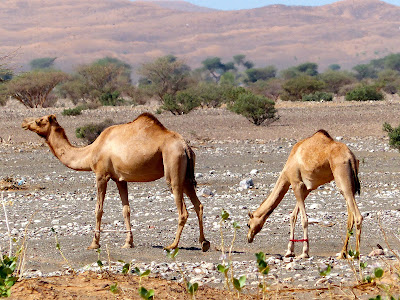After tasting some local
halwa (a delicacy made of eggs, sugar, corn flour, saffron and puréed dates), we filled our hire car up with petrol and left
Muscat to head along and down the east coast for some more
diving.
 |
| Omani halwa |
 |
| petrol priced at the equivalent of €0.27 per litre |
 |
| near Qantab |
 |
| view from the Shangri-La Hotel Al Husn |
 |
| Quriyat, a fishing village an hour's drive from Muscat |
 |
| at Qurayat |
 |
| at Wadi Tiwi |
 |
| at Wadi Tiwi |
 |
| sea arch, Bandar Al Jissah |
We arrived at
Ras al-Jinz, the easternmost point of the Arabian Peninsula, and an important nesting site for an estimated 20,000 green turtles each year that migrate from as far as the Red Sea and the East African coast. Turtles can be seen virtually year round, but especially between September and November.
 |
| a dhow at Ras Al Hadd, near Ras al-Jinz |
The
Ras al-Jinz Turtle Reserve offers visits at night and dawn, but you can only take photos during the early morning visit as the turtles risk returning to the site without laying if they are disturbed by camera flashes at night. So although it meant a very early rise, we chose a dawn visit, starting at 5am.
 |
| a turtle hatchling |
A limited number of visitors is allowed per viewing.
 |
| Turtle finishing egg-laying |
 |
| Turtle heaving herself out of the sand after laying eggs |
 |
| Turtle tracks |
 |
| Turtle heading back into the sea at sunrise after laying eggs |
 |
| Turtle heading back into the sea after laying eggs |
On the road between the city of
Sur and "Turtle Beach" (Ras al Hadd) a tiger has been painted the side of the roadside cliff as some locals felt it was shaped like a tiger.
 |
| Tiger! |
When we left Ras al Jinz and started to head
inland we saw the following sign:
 |
| Beware of the camels! |
Effectively, we started seeing more and more camels everywhere.
 |
| camels bred for camel racing, Wahiba Sands |
You may also like:






















No comments:
Post a Comment